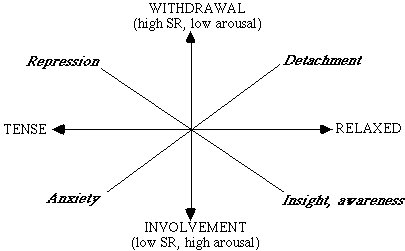The Use of Biofeedback in Therapy
by Peter Shepherd
The Biofeedback Monitor, a Galvanic Skin Resistance (GSR) psychometer used in Transformational Psychology therapy, measures the energetic charge that exists in the mind on any item or topic being examined. The meter measures the skin resistance of the body, which varies extremely rapidly according to the degree of arousal of the autonomic nervous system, whether reaching towards ('fight') or moving away ('flight').
The overall (basal) reading of skin resistance, itself provides the analyst with useful information about the subject. Values lower than 5K ohms indicate a high level of brain arousal, with high anxiety (towards overwhelm) and concentrated introspection. At the other extreme, values higher than 25K ohms indicate low arousal and withdrawal from the mind (dissociated states of poor concentration, limited self awareness, non-confront, over-restimulation, boredom, fantasy, switch-off, apathy). Readings between these extremes indicate progress of the case during a session of therapy.
When repressed material is coming to the surface (e.g. material associated with guilt), the skin resistance rises and the client experiences feelings of tension, that is, if he is 'in session', interested in his own case and involved with his inner feelings, in a paratelic mode of experiencing rather than a telic figure-figure. Then, when the repressed material reaches the surface and the negative emotion discharges (often causing some anxiety in the process, but with the help of the counsellor this can be overcome and the material confronted). There is usually a large drop in skin resistance and the client experiences relief.
Out of session such restimulation, if slight, may cause detachment as an effort to withdraw and be relaxed, but when the restimulation increases, anxiety arises and inevitable tension. The state of withdrawal is relaxed when it results from detachment from worldly cares or abandoning responsibility; or withdrawal is experienced as tense when there is an inability to confront repressed material or circumstances. Involvement is experienced as tense when matters are confronted but unresolved, or it becomes relaxed when there is a flash of insight and the blockage is cleared away. If that which is being confronted becomes overwhelming, arousal may become too high and the person may revert to withdrawal and detachment again.
The following diagram illustrates the state of arousal of the autonomic nervous system as measured by skin resistance, plotted against the subjective experience of being relaxed or tense:

When restimulation is confronted, repression dissolves into awareness. When not confronted, detachment may suffice but if further involvement is enforced, anxiety results.
A high level of arousal can be pleasant and exciting when a person is relaxed and aware, with integrated hemispheric arousal, such as when insight has been gained in counselling; or high arousal may be experienced as unpleasant when tension exists, trauma is being repressed and one hemisphere is aroused more than the other. Proportional to a student's erasure or transcendence of traumatic material, there is an increased capacity to operate at high arousal, in a relaxed state without discomfort.
Move on to Use of the Biofeedback Monitor.
Return to Transforming the Mind - Contents.